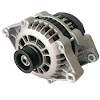Commutation
The E.M.F. induced in each coil on the armature of a d.c generator alternates with a frequency corresponding to the product of the speed and the number of pairs of poles. To obtain direct currents in the external circuit, we need commuctator and brushes. As conductors pass out of the influence of a N-pole and enters S-pole, the current in them is reversed. This reversal of current takes place along brush axis i.e. when the brush short circuits that particular coil undergoing reversal of current through it. This process by which current in a short-circuited coil is reversed while crossing the M.N.A. Is called commutation. The period during which the coil remains short-circuited is called commutation period and represented by Tc.
If the current reversal i.e., the charge from + I to zero and then to – I is completed by the end of short circuit or commutation period, then commutation is ideal. If the current reversal is not completed by that time, then sparking is produced between the brush and the commutator which resukts in progressive damage to both.
For the study of commutation, let us consider that the machine has a ring winding, a part of which is show in fig. concentrate on coil B.
a) Coil B is about to short circuited because brush is about to come in touch with segment ‘c’. it is assumed that each coil carries 20A, so brush current is 40A.
b) Coil B has entered its period of shot-circuit and is approximately at one-fourth of this period. The current through coil B has reduced from 20A to 10A (from right to lift). The segment ‘b’ carries 30A and the segment ‘c’ 10A, the total being 40A at the brush.
c) The coil B is in middle of short-circuits period. The current through it has reduced to zero. The two coil A and c supply a current of 20A each through segments ‘b’ and ‘c’ Respectively.
d) One-fourth brush is under is under segment ‘b’, (which is decreasing). The coil B carries 10A in the reverse direction which combines with 20A supplied by coil C to make 30 A that passes through segment ‘c’ to the brush the other 10A supplied by coil A passes through segment ‘b’, thus total of 40 A at the brush.
e) The coil B is at the end of short-circuits period. The current through B should be 20 A, but it is carrying 15 A only. The difference current 5 A jumps from segment ‘b’ to the brush through air thus producing spark.
f) Represents the changes of current through coil B on a time base. If current through coil B changes from its +20 A to Zero and then to -20 i.e. BC is a straight line, then it is referred to as linear commutation. But, due to self induced e.m.f. (also known as reactance voltage) in coil B the variation follows the dotted line BK, that it is referred to as under commutation. The main cause which retards or delays the quick reversal of current is the production of self induced e.m.f. in the coil undergoing commuatation. It should be noted that the coil possesses appreciable self inductance. This self induced e.m.f. is also known as reactance voltage.
Methods of improving Commutation
There are two methods of improving commutation i.e. of making current current reveral in the short-circuited coil as sparkless as possible. They are:
i) Resistance commutation.
ii) EMF commutation (it is done with the help of brush-lead or interpoles).
Resistance commutation
This method of improving commutation consists of replacing low resistance copper brushes by comparatively high resistance carbon brushes. The current I in coil A has two paths to reach the brush. The first path is straight from segment ‘b’ to the brush and the other path is via short-circuited coil B to segment ‘c’ then to brush. If the copper brushes (low resistance) are used, the current follow the first path but not the second longer path. If high resistance carbon brushes are used, then the current I coming from coil A will prefer second loner path because
(i) The first path resistance will increase due to diminishing area of contact of brush with segment ‘b’ and because
(ii) Resitance of second path will decreases due to repid increasing contact area of segment ‘c’ with the brush.
The main cause of commutation is the self-induced e.m.f. (reactance voltage), so high resistance carbon brushes alone do not give a sparkles commutation, but they help in obtaining it. Another advantages of carbon brushes is that, they lubricate and polish the rotating commutator. The carbon brushes causes voltage drop due to high contact resistance (approximately 2v).
Advantages of carbon brushes
1) Improves the commutation.
2) Lubricate & polish the commutator.
3) Easily available in the market.
4) Economical.
Disadvantages of carbon
1) Causes voltage drop due to high contact resistance.
2) Needs to be replaced due to wear.
E.M.F. Commutation
In this method, Arrangement is made to neutralize the reactance voltage by producing a reversing e.m.f. in the short-circuit coil. If reversing e.m.f. is made to be exactly equal and opposite to reactance voltage, the current in short-circuit coil will reverse quickly, which result in sparkles commutation. The revering e.m.f. may be produced in two ways
i) Either by giving the brush a forward lead sufficient enough to bring the short-circuited coil under the influence of next pole of opposite polarity or
ii) By using interpoles.
The first method was used in early machines but now it has been ruled-out due to many other difficulties it brings along with it.












0 Comments